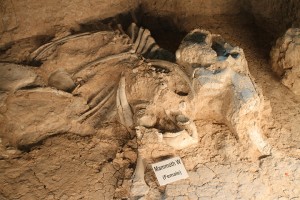
The Waco Mammoth site is currently in the process of applying for national monument status. Similar legislation was put in the works last year, but died in the U.S. Senate last year.
By Linda Nguyen
Staff Writer
It’s humongous news: mammoth actually.
On June 19, the U.S. House of Representatives passed bill H.R. 2578, the Conservation and Economic Growth Act, which could turn the Waco Mammoth Site into the Waco Mammoth National Monument. Now the bill only needs to pass the Senate to become official.
“The Waco Mammoth Site is one of four ice age paleontological sites in the United States,” said Don Esker, program coordinator for the Waco Mammoth Site.
“We have the remains of six Columbian mammoths from 68,000 to 53,000 years ago, an ice age camel, an ice age giant tortoise and a saber-tooth cat,” Esker said. He said this is the second time the site has been put before Congress to become a national monument.
In 2009, the bill was put on secret hold by the Senate, which occurs when one or more senators prevents a motion or bill from reaching a vote on the Senate floor.
“It didn’t pass in 2009 because of the fiscal environment at the time,” U.S. Rep Bill Flores, R- Bryan said. “The Senate thought it was inappropriate because money was so tight.”
Flores said the current bill is the same as the one in 2009, except the new version states that McLennan County will reimburse the National Parks Services for the cost of maintaining the national monument.
“When [the bill] was reintroduced, it was modified,” Esker said. “We’re not asking for federal funding. It will still come from local sources like the city of Waco.” Becoming a national monument would help raise awareness of the site, Esker said.
“The name counts a lot,” Esker said. “We’re hoping for more exposure, and the National Parks Service has huge resources to bring this to the attention of the public and show that we exist to the rest of the world. The other sites get about half a million visitors a year. We get about 20,000,” Esker said. “The site is important enough that we should be getting people from all across Texas, all across the United States, even all across the world.”
Esker said the site as a national monument would attract tourists to Waco and help it raise money. The site is supported locally by donations from people in the community through the Waco Mammoth Foundation. With more recognition, the site would be able to raise more money to continue to improve the site.
Flores also hopes that as a national monument, the site will attract more people to Waco.
“I think if it gets the recognition it deserves, families and researchers from all over the world will come and see it,” Flores said. “It will bring a huge influx of people to McLennan County.” Dr. Steven Driese, Baylor professor and chair of the geology department, is excited about the site’s potential importance.
Driese worked with the site in 2007 when a former graduate student, John Bongino, completed his master’s thesis on the history of the Waco Mammoth Site. “I would love to see a sign on I-35 directing people how to get off to get to the mammoth site and have that United States National Parks logo,” Driese said. “It would mean a lot to the city.”
Driese said the Terrestrial Paleoclimatology research group, consisting of faculty and student research that seeks to reconstruct the Earth’s ancient climate history from the terrestrial deposit, would be able to learn a lot from the site as soon as the group is able to open up more scientific investigations.
“[The site] would give us a better interpretation on how the mammoths accumulated, how they died, and also if there are additional fossil mammoths that haven’t been uncovered, and I think there’s evidence that there are,” Driese said.
The site, which was closed off until 2009, is currently being renovated to make it more accessible and to help people learn about the animals that once occupied Waco. The site is also awaiting reopening to scientists and researchers. The first phase of the construction, completed in 2009, included the building of the exhibit facility over the site itself as well as the welcome center.
“Our second phase will be to construct a Children’s Discovery Center, a place where children can use the tools paleontologists use in order to dig up replica bones,” Esker said. “Our third and final phase would be to open up an indoor exhibit and laboratory so we can replace some of the bones moved by Baylor and we can start excavating again.” The site will be expanded as funds are acquired.
Driese said members of terrestrial paleoclimatology research initiative of the geology department and other department staff are excited to see a permanent structure built on the site and to hear about the possibility of a lab in the future. “It used to be only covered by a tent,” Driese said. “The rain would wash through the site and basically erode the site away.”
Analise Dolan, a full-time employee of the Waco Mammoth Site, said she enjoys her job, which includes everything from acting as tour guide to being a cashier at the gift shop. Dolan has been working at the site for a year and a half.
“I do a little bit of everything here and it’s really great,” Dolan said. “I feel like it would be really awesome for the site to become a national monument. It would get recognition here as well as international recognition. People like to visit national parks.”
The Waco Mammoth Site is open to the public from 11 a.m. to 5 p.m. Tuesday through Friday, and from 9 a.m. to 5 p.m. on Saturday. Admission for adults is $7, with $1 discounts for seniors, veterans, children and students.



